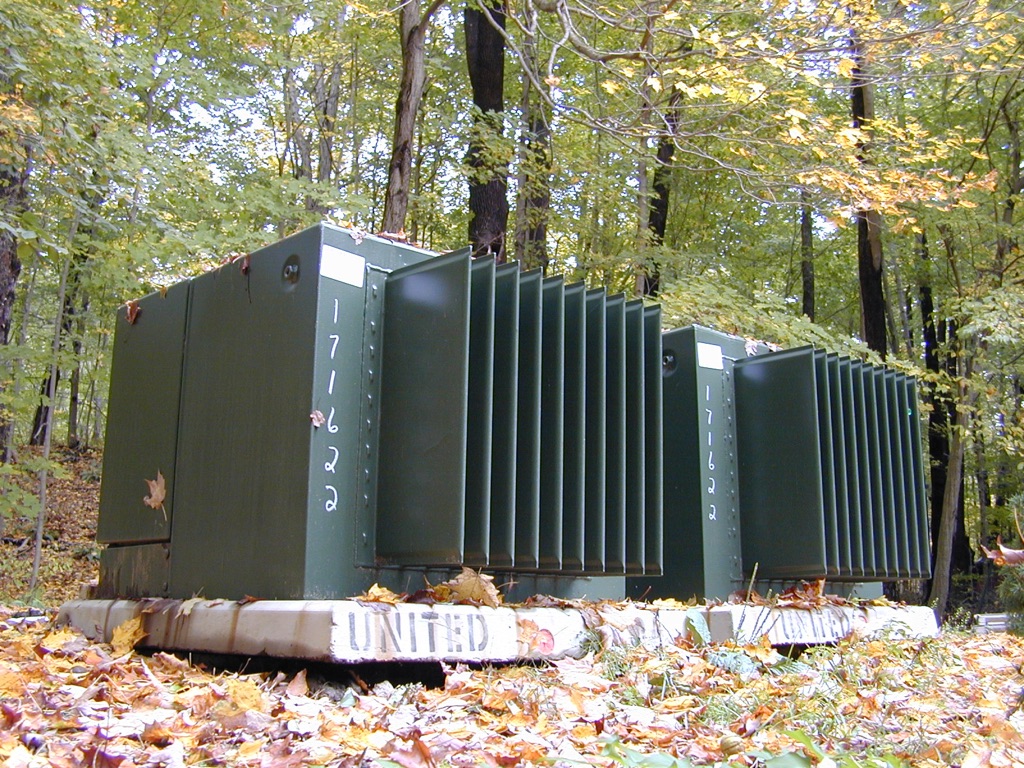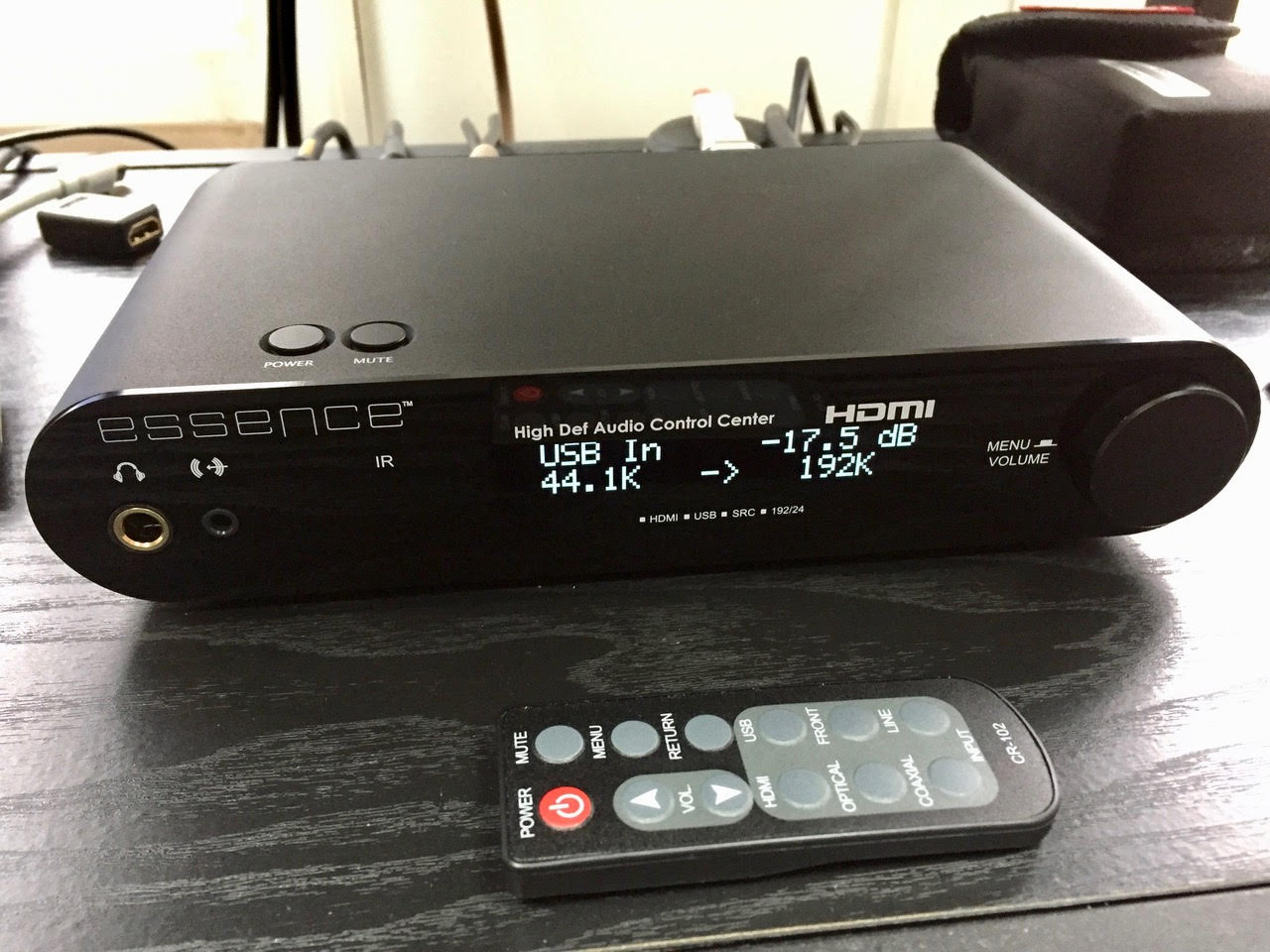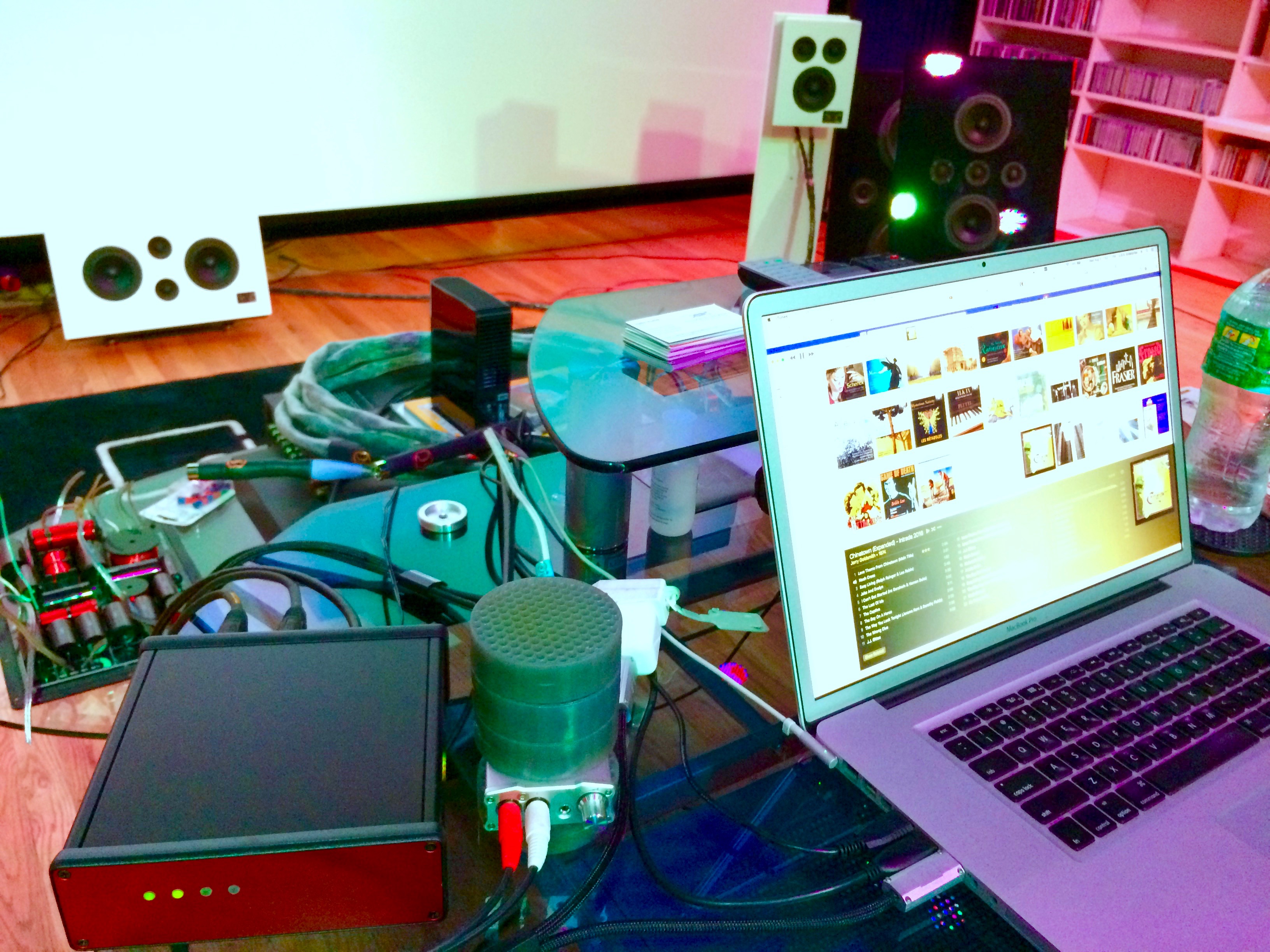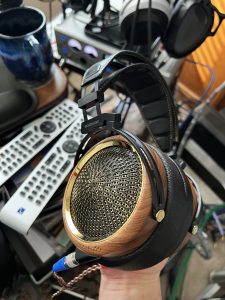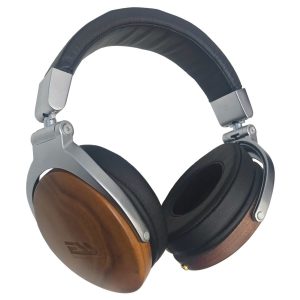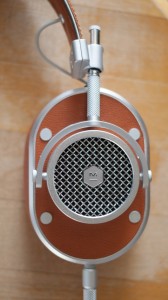QUESTION: "What cans do you like to listen to? What do you hear as differences between speakers and headphones in terms of how they present sound?"
ANSWER: "Good question. For myself, I use an ALO modded Grado 225 and Senn 600 for some recording work but I find the midrange on the Senn is not perfect for my violin recordings. The difference is clearly the soundstage presentation on can is very different from my Maggies at home. I'm not sure this answers your question as I think Jeremy may have a different view..."
"Cans", a colloquialism used by audio engineers to describe the sound and wearability of headphones, are a part of most everyone's lives each and every day. But in particular, they are involved in the production of sound as heard on Albums, Movies, TV, Live Sports, and Video Games (to mention but a few). Before consumers ever hear any of the their familiar program sources, a sound engineer has listened to them at length, made adjustments, equalized frequencies, compressed dynamics, added reverb, sequenced songs, and mastered the audio using headphones as one of the most critical parts of the entire production process. So is it any wonder that recordings sound so different from each other and when heard on loudspeakers? What's going on, here?
When "Cans" were first invented (at the beginning of the 20th Century), they were initially used by the U.S. Navy, and later as part of the telephone and radio industries. You probably have seen the old telephone earpieces that accompanied hand-crank telephones: basically an acoustic lens made of wood (or Bakelite) that amplified a tiny diaphragm moving in response to an incoming electrical signal. So as long as voices were clear (a big if, in those days), the design was satisfactory. In fact, the basic sound quality of "Cans" remained largely unimproved, even through the early "Stereo" era of the late 1950's, as headphones would come to be used to make high fidelity recordings.
Over the years, I have listened to a lot of headphones, as well as a lot of speakers. In my pursuit of making extremely transparent "You Are There" holographic recordings, which are captured with just a single-stereo microphone, I always refer to earlier great recordings in my collection. I use these as a reference against which to evaluate the new sounds I am capturing. When I conduct a sound check, it involves many changes in the musician's position as well as the height and distance of the microphone within the acoustic space chosen. Not to mention isolating and eliminating any stray source of sound or noise before the first take happens.
In my many years as a Tonmeister (audiophile recording producer, engineer & musician) I have found it necessary to utilize headphones as an important part of an album's creationary processes. In fact, when making professional recordings of any kind, headphones must be an engineer's primary tool; that is... right after the microphone(s), of course. Whether creating music albums simply using two-channel stereo, or capturing multi-channel sound ‘scapes for use in multimedia presentations, the sound captured has all been evaluated and mixed using headphones as the primary monitoring tool, at some point. That is a large responsibility for what in most cases is either the cheapest or the most colored part of the recording process.
When I first began working as a recording engineer in 1990, I was lucky enough to be hired by Bob Katz, and to work with Steve Guttenberg (The Audiophilliac), David & Norman Chesky of Chesky Records in New York City. The audiophile label's goal was to create the illusion of live musicians performing within a real three-dimensional space: the impression of reality, basically. And I was systematically introduced to and taught how to utilize the most advanced recording technologies available at the time, along with careful microphone placement to achieve aural holography. I became part of a recording team that paid strict attention to every minute detail of the production. The result: a listening experience where each album is tangible, pleasurable, exciting, and realistic to experience. Amazingly, we would never have achieved this without the use of headphones (as well as loudspeakers, of course), and here is why.
The first part of any recording session involves choosing a location with an appropriate acoustic (room sound) that will suit the music and the musicians appearing on the album. Typically in our industry, a specially built recording studio with adjustable walls and reverberation character is chosen; making the production process far more malleable, quieter, and more comfortable than on location, somewhere out in the world. Yet, this can reduce the actual acoustic contribution since it must be largely created: a synthetic backdrop of sound. Any "Room Sound" is essentially lost in the mix of microphones (sometimes more than one for each instrument) and effects tracks. But… not for any of the Chesky Productions!
Accurate sound presentation was the gold standard, and I learned quickly how and why the use of a single Stereo Blumlein Microphone (known as a Figure-8) can capture almost exactly what the company's charter specifies. Judiciously placed to hear both the musicians and the acoustic space in perfect proportion, Bob Katz would listen to the microphone feed using his STAX headphones, and make minute adjustments that produced uncanny sonic illusions on the finished album. Even though the sound of the space and the timbre of the instruments is different on "Cans" then it is on Loudspeakers, Bob's keen hearing could extract and localize all the specifics, which need to be carefully balanced when making a recording. The rest of the team listened on both headphones and loudspeakers; both part of a large number of such audio transducers (each with their own colorations), which evolved through the four years that I worked here.
Several types of headphones were always on-hand in order to closely monitor any variations in sound quality; from imaging and sound staging issues, to extraneous noises or even wrong notes. These "Cans" included:
1) STAX Lambda Signature, with either the stock Solid State or the Tube Amplifier combination
2) My personal set of SONY CD-999, with the Diamond Amorphous Heads – Woot Woot !!
3) The RCA/BMG Studios ubiquitous SONY CD-6 (for musicians out in the studio)
4) The RCA/BMG AKG Acoustics K-240 Semi Open Studio Headphones (for engineers in the control room)
5) Original GRADO HP-1S with the Signature Ultra-Wide Bandwidth Reference Cable (owned by our RCA/BMG liaison engineer, Bill Allen).
6) Etymotic Research ER-4B (Part of my portable recording ensemble, since 1991)
7) BeyerDynamic DT-990 (on loan from BeyerDynamic for testing by our engineering team)
Not surprisingly, none of these 1990 – 1994 era "Cans" sounded like the others! They were all totally different in character from each other, from reality, and from speakers; in so many important ways. But they each offered a specialized opportunity to observe the sound that we were creating on multiple transducer platforms, as the various Chesky projects unfolded. Because the coloration in most headphones is so great, it is fair to say there choice is a matter of personal taste. But certain characteristics remain consistent from Headphone to Headphone, and (based on the requirements of making an album) these are my observations and preferences amongst those candidates, in order of listening preference:

STAX Lambda Signature Electrostatic Ear Speakers were the least colored through the midrange of any of the candidates; revealing minute differences in microphone and musician placement as well as adjustments to the room's size and the disposition of reflective versus absorptive surfaces. On the down side, dynamics were compressed, and the ability to play them really loudly was rarely there, except with Bob's tweaked STAX Solid State amplifier—piping HOT!!!
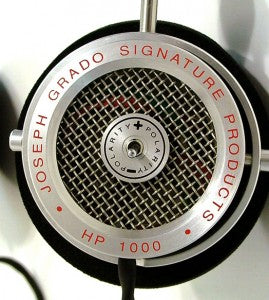
GRADO HP-1S had an extremely well-balanced sound, with heart-throbbing palpability and gobs of Bass dynamics, they also threw a very large, wide, and deep soundstage; unusual for "Cans". This kind of Bass dynamics was almost totally absent from the STAX Earspeakers.

BEYERDYNAMIC DT-990 were a clear winner for their well balanced, three dimensional presentation. While not offering the delineation of musical information found in either the STAX or the GRADO, their overall clear sonic view of our work made them a necessity to listen with; particularly for resolving noise related issues in the studio environment.

AKG K240 did very little that was wrong, but they also sound veiled in both the treble and the midrange to a degree that instrumental timbres and percussion lost definition as the sound built in intensity and volume. What the AKG lacked in finesse, it made up for by being relatively inexpensive and also very comfortable to wear for hours at a time; an important issue in a professional environment, where we often worked well into the night.

The two SONY headphones sounded much more similar to each other than you might expect; despite the 1-times difference in pricing. A bit like listening down a cardboard paper towel roll, the sound from the more expensive CD-999 was full frequency (20Hz – 20kHz), and detailed, with a moderately sized soundstage, capable of delineating depth, but no height and little impression of rear sounds. While the less expensive CD-6 ended up squashing the soundstage flat as a pancake, along with crushing the dynamics, and lopping off both the top and bottom octaves, I nevertheless found them to sound better than of the SONY Walkman headsets, sold in the late 1970's to the present.

Etymotic Research claimed flat in-ear response for their "B" (for Binaural) version of the ER-4 Ear Canal Speaker (back in 1990). And although certain details of midrange and treble were indeed amazingly true sounding, there was a lack of real bass, causing a generally bright, thin sound that was not very audiophile. But I used them primarily with my SONY PCM Portable DAT system (D7 & D8), and in that role they were more suited to fieldwork where noise isolation and repeatability of high quality playback under harsh sonic conditions is paramount.
Naturally, the speakers we used produced yet another variation in the reproduced sound quality, and we had many, many speaker types on-hand including B&W 801, CLS Z Mod, and A3 Electrostatic models. But rarely did they create the intimacy that we achieved listening with headphones. Yet, the palpable impression of musical instruments imaging outside of one's head is only a real possibility with a well set-up set of speakers, where a keen ear will clearly detect nuances in height, width, and depth of the soundstage from well-engineered recordings that are simply and almost totally hidden while listening with headphones. Unfortunately, no amount of processing has yet produced a complete loudspeaker listening experience through a pair of "Cans", and so a great dichotomy in the presentation quality continues to exist between these two popular transducer types. Yet there will always be a place for headphones alongside a "good" pair (or more) of loudspeakers. And if you listen closely to the recommended recordings I've listed (below) while auditioning your next pair, you won't be able to help picking the best headphones, for you!
BIO: Jeremy R. Kipnis is a producer and engineer of audiophile recordings since 1988. His label, Epiphany Recording Ltd. pioneered the first High resolution Single Stereo Microphone recordings at 192 kHz / 24-bits in 1994. This evolved into an internationally awarded A/V playback and editing room design, known as the Kipnis Studio Standard (KSS). He reviews audio, video, and home theater technology for many periodicals throughout the world, and is a frequent guest commentator on television and the internet regarding Ultimate Home Theater and Cinema Technologies. He has been awarded the Guinness World Records Award for "Most Technically Complex Home Theater System in the World" from 2007 - 2014.
SUGGESTED LISTENING: Chesky Records / Produced from 1990 – 1994
CLASSICAL
CD75 – The Virtuoso Scarlatti w/ Igor Kipnis
https://www.hdtracks.com/index.php?file=catalogdetail&valbum_code=090368007520
CD78 – Vivaldi: The Four Seasons w/ Igor Kipnis Conducting The Connecticut Early Festival Ensemble
JAZZ
JD49 – Clark Terry Live at the Village Gate
https://www.hdtracks.com/index.php?file=catalogdetail&valbum_code=090368004925
JD68 – Live at The Village Gate: The Second Set
https://www.hdtracks.com/index.php?file=catalogdetail&valbum_code=090368012722
VOCAL
JD55 – Because of You w/ Kenny Rankin
https://www.hdtracks.com/index.php?file=catalogdetail&valbum_code=090368006325
BLUES
JD48 – NATASHA
https://www.hdtracks.com/index.php?file=catalogdetail&valbum_code=090368004826
LATIN
JD63 – Amazonia w/ Ana Caram
https://www.hdtracks.com/index.php?file=catalogdetail&valbum_code=090368004529
TEST & SAMPLER
JD68 - Best Of Chesky Jazz And More Audiophile Tests Volume 2
https://www.hdtracks.com/index.php?file=catalogdetail&valbum_code=090368006820
Review System (at Kipnis Studios & Epiphany Recordings Ltd.):
(items in Bold are on loan from the manufacturer)
DIGITAL-to-ANALOG decoders: ifi DSD 384 kHz 2xDSD Portable DAC, PS Audio PowerWave DAC II (with Bridge Card), Theta Digital Generation VIII DAC (Mk. 3 updates), Ultra-Analog A/D D/A (Custom Pro Tools 24-bit Recording System).
DIGITAL SOURCES: Mark Levinson No. 51 DVD-A Transport, Mark Levinson No. 37 CD Transport
Macbook Pro 17" 2.5 GHz Intel Core i7 . 8 GB 1333 MHZ DDR3 / 10.9.3 OS, Audirvana Plus (Memory Music Player for iTunes, v. 1.5.12), Pure Music 1.8 & 2.1 (High-Rez Memory player for iTunes), Decibel (Memory Music Player for iTunes), AudioGate (Media Player).
ANALOG SOURCES: ELP Laser Turntable LT-X2A (Custom Line-Level Output Cards w/ RIAA Correction), Technics SP-15 / SME 3009 Mk. 3 Arm / Shure V15-MRx Cartridge, TEAC 6010 ¼" 2- track & 4-track Stereo Reel-to-Reel Player, Pioneer RTR-909 (Reel to Reel Recorder)
PRE-AMP / VOLUME Controls: Audible Illusions Tube Pre-Amp / Phono Stage, Melos SHA-GOLD Tube Pre-Amp, Ultimate Attenuators (x2) – (31-step Laser Matched Resistors w/ Penny & Giles), Yamaha DSP-3000 Acoustic Room Simulator.
AMPLIFICATION: Crown - Macro Reference (x2) – Class A Modified, Carver - VTA20S Tube (x2) (Pair running in Bridged Mono), Mesa Boogie - Baron Stereo Tube Amplifier (with adjustable feedback and variable Triode-to-Pentode performance), McIntosh MC2102 Stereo or Mono (x2) & MC2301 Monoblock (x2) Tube Amps, Mark Levinson No. 31.5 Monoblock (x2).
SPEAKERS: Symdex Epsilon 3-Way Loudspeakers (Built in 1993 by Kevin Voecks and Leeland Wallace in Gloucester, Massachusetts - USA) w/ Subwoofer (self Powered 12"): Cambridge Soundworks (x4), Ologe ZERO • 0: 2-way Loudspeakers, Ologe ONE • 1: 2-way Loudspeakers, Ologe FIVE • 5: 2-way Loudspeakers, Ologe TEN • 10: 3-way Loudspeakers, Snell Music & Cinema Reference Full Range 4-way Tower Loudspeakers, Snell Music & Cinema Reference SUB-1800 (18") Passive Subwoofer (x4), Bryston Stereo Subwoofer Crossover (x2).
INTERCONNECTS, WIRES & CABLES: Skogrand SCI Markarian 421 (3-Meters: Balanced & Unbalanced Pairs), Skogrand SC Air Speaker Cable (3-Meter Pair), Skogrand SC Centaurus A Speaker Cable (3-Meter Pair), Skogrand SC Markarian 421 Speaker Cable (3-Meter Pair & 1.5 Meter Pair), Cardas Golden V Cables, Interconnects, Power Cords, Digital Connections, Microphone Cables, LessLoss HPLC Power Cords (x4), AudioQuest Ruby Speaker Cables & Interconnects, Glass Optical and HDMI Cables, Monster Cables M1 & M1000 Speaker & Interconnect, Pro 500 Microphone Cables, Mapleshade 1st Generation Experimental Speaker, Interconnect, and Digital Wires, Straight Wire, Kimber, Goldmund, Nordost, Sony, Panasonic, Radio Shack, RCA, etc..
TWEAKS and ACCESORIES: ifi iUSB - Split Wire Specialized USB Audio Cable – 2.5 meters. ifi iConditioner – USB Audio Interface and Signal Normalizer, LessLoss Blackbody Ambient Field Conditioners (x5), Magic Hexa Vibration Control Feet - 4 feet (x2), Solid Tech Rack of Silence w/ Feet of Silence (x5), Auralex 4" Studio Wedge Foam 2' x 2' Panels (x6), ASC Special SQUARE Tube Traps (x2), DIRAC Live Room Calibration Kit (with xyz microphone), Equitech 100 KVa Balancing Transformer (x2 : separate Digital and Analog services).
HEADPHONES and RELATED PRODUCTS: ifi iCan Discrete Class-A Headphone Amplifier, BeyerDynamic T-1, BeyerDynamic DT-990, STAX Lambda Signature Headphones w/ TR, M-T1 Tube Amplifier, SONY CD-999 Headphones w/ OFCLW Cabling & Diamond Amorphous Heads, SONY CD-6 Over-Ear Studio Headphones, AKG K-240 Semi Open Over Ear Studio Headphones , GRADO HP-1S On-Ear w/ Signature Ultra-Wide Bandwidth Reference, Etymotic Research ER-4B & ER-4S In-Ear Canal Phones.




